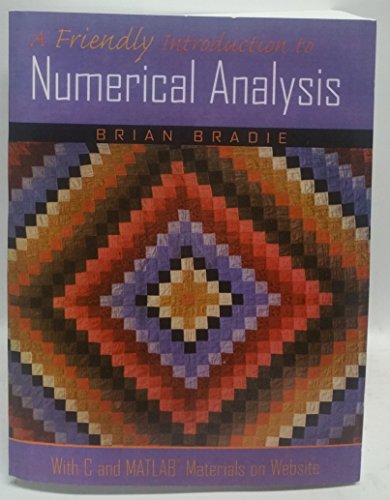
Synopsis
For one or two-semester undergraduate/graduate-level courses in Numerical Analysis/Methods in mathematics departments, CS departments, and all engineering departments.
This student-friendly text develops concepts and techniques in a clear, concise, easy-to-read manner, followed by fully-worked examples. Application problems drawn from the literature of many different fields prepares students to use the techniques covered to solve a wide variety of practical problems.
"synopsis" may belong to another edition of this title.
From the Back Cover
This reader-friendly introduction to the fundamental concepts and techniques of numerical analysis/numerical methods develops concepts and techniques in a clear, concise, easy-to- read manner, followed by fully-worked examples. Application problems drawn from the literature of many different fields prepares readers to use the techniques covered to solve a wide variety of practical problems. Rootfinding. Systems of Equations. Eigenvalues and Eigenvectors. Interpolation and Curve Fitting. Numerical Differentiation and Integration. Numerical Methods for Initial Value Problems of Ordinary Differential Equations. Second-Order One-Dimensional Two-Point Boundary Value Problems. Finite Difference Method for Elliptic Partial Differential Equations. Finite Difference Method for Parabolic Partial Differential Equations. Finite Difference Method for Hyperbolic Partial Differential Equations and the Convection-Diffusion Equation. For anyone interested in numerical analysis/methods and their applications in many fields
"About this title" may belong to another edition of this title.
Other Popular Editions of the Same Title
Search results for A Friendly Introduction to Numerical Analysis.
A Friendly Introduction to Numerical Analysis
Seller: ThriftBooks-Dallas, Dallas, TX, U.S.A.
Paperback. Condition: Fair. No Jacket. Readable copy. Pages may have considerable notes/highlighting. ~ ThriftBooks: Read More, Spend Less. Seller Inventory # G0130130540I5N00
A Friendly Introduction to Numerical Analysis
Seller: ThriftBooks-Atlanta, AUSTELL, GA, U.S.A.
Paperback. Condition: Good. No Jacket. Pages can have notes/highlighting. Spine may show signs of wear. ~ ThriftBooks: Read More, Spend Less. Seller Inventory # G0130130540I3N00
A Friendly Introduction to Numerical Analysis.
Seller: -OnTimeBooks-, Phoenix, AZ, U.S.A.
Condition: good. A copy that has been read, remains in good condition. All pages are intact, and the cover is intact. The spine and cover show signs of wear. Pages can include notes and highlighting and show signs of wear, and the copy can include "From the library of" labels or previous owner inscriptions. 100% GUARANTEE! Shipped with delivery confirmation, if you're not satisfied with purchase please return item for full refund. Ships via media mail. Seller Inventory # OTV.0130130540.G
A Friendly Introduction to Numerical Analysis.
Seller: BooksRun, Philadelphia, PA, U.S.A.
Paperback. Condition: Very Good. 1. It's a well-cared-for item that has seen limited use. The item may show minor signs of wear. All the text is legible, with all pages included. It may have slight markings and/or highlighting. Seller Inventory # 0130130540-8-1
Friendly Introduction to Numer
Seller: World of Books (was SecondSale), Montgomery, IL, U.S.A.
Condition: Good. Item in good condition. Textbooks may not include supplemental items i.e. CDs, access codes etc. Seller Inventory # 00095835847
A Friendly Introduction to Numerical Analysis.
Seller: HPB-Red, Dallas, TX, U.S.A.
Paperback. Condition: Acceptable. Connecting readers with great books since 1972. Used textbooks may not include companion materials such as access codes, etc. May have condition issues including wear and notes/highlighting. We ship orders daily and Customer Service is our top priority! Seller Inventory # S_439802045
A Friendly Introduction to Numerical Analysis.
Seller: HPB-Red, Dallas, TX, U.S.A.
Paperback. Condition: Good. Connecting readers with great books since 1972! Used textbooks may not include companion materials such as access codes, etc. May have some wear or writing/highlighting. We ship orders daily and Customer Service is our top priority! Seller Inventory # S_440402121
A Friendly Introduction to Numerical Analysis.
Seller: Textbooks_Source, Columbia, MO, U.S.A.
paperback. Condition: Good. 1st Edition. Ships same day or next business day! UPS shipping available (Priority Mail for AK/HI/APO/PO Boxes). Used sticker and some writing and/or highlighting. Used books may not include working access code. Used books will not include dust jackets. Seller Inventory # 000639375U
A Friendly Introduction to Numerical Analysis.
Seller: Toscana Books, AUSTIN, TX, U.S.A.
Paperback. Condition: new. Excellent Condition.Excels in customer satisfaction, prompt replies, and quality checks. Seller Inventory # Scanned0130130540
Friendly Introduction to Numerical Methods
Seller: GreatBookPrices, Columbia, MD, U.S.A.
Condition: good. May show signs of wear, highlighting, writing, and previous use. This item may be a former library book with typical markings. No guarantee on products that contain supplements Your satisfaction is 100% guaranteed. Twenty-five year bookseller with shipments to over fifty million happy customers. Seller Inventory # 820283-5

